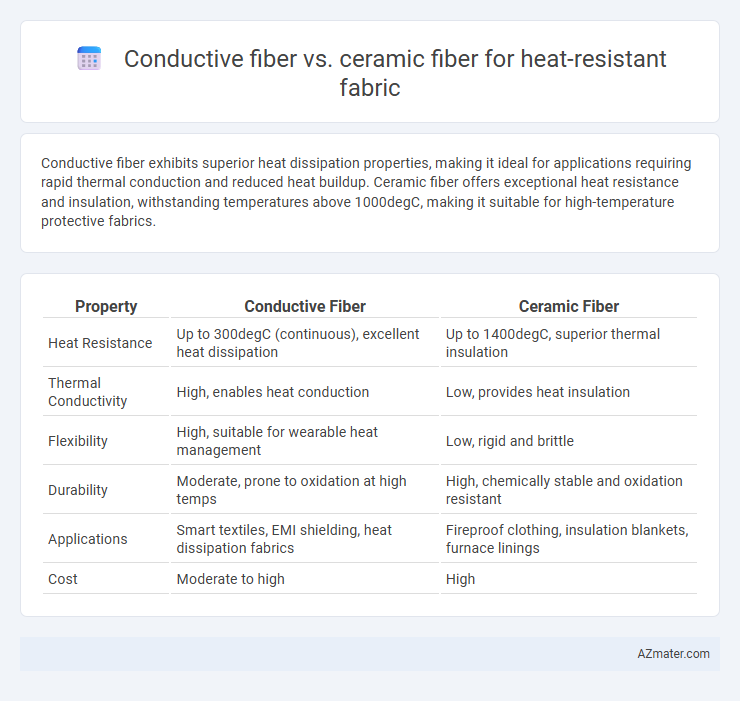Conductive fiber exhibits superior heat dissipation properties, making it ideal for applications requiring rapid thermal conduction and reduced heat buildup. Ceramic fiber offers exceptional heat resistance and insulation, withstanding temperatures above 1000degC, making it suitable for high-temperature protective fabrics.
Table of Comparison
| Property | Conductive Fiber | Ceramic Fiber |
|---|---|---|
| Heat Resistance | Up to 300degC (continuous), excellent heat dissipation | Up to 1400degC, superior thermal insulation |
| Thermal Conductivity | High, enables heat conduction | Low, provides heat insulation |
| Flexibility | High, suitable for wearable heat management | Low, rigid and brittle |
| Durability | Moderate, prone to oxidation at high temps | High, chemically stable and oxidation resistant |
| Applications | Smart textiles, EMI shielding, heat dissipation fabrics | Fireproof clothing, insulation blankets, furnace linings |
| Cost | Moderate to high | High |
Introduction to Heat Resistance Fabrics
Heat resistance fabrics are designed to withstand extreme temperatures while maintaining structural integrity and performance. Conductive fibers, often made from metals or carbon, provide excellent heat dissipation and conductivity, making them ideal for applications requiring thermal regulation. Ceramic fibers, composed of alumina and silica, offer superior insulation and resistance to high temperatures, making them essential in industries such as aerospace and firefighting for thermal protection.
Overview of Conductive Fibers
Conductive fibers are engineered materials designed to efficiently transfer heat and electrical signals, making them ideal for applications requiring both thermal management and electrical conductivity. These fibers often incorporate metals like silver, copper, or carbon-based materials such as graphene to enhance their conductive properties while maintaining flexibility and durability. Compared to ceramic fibers, conductive fibers offer superior heat dissipation and electronic functionality but may have lower maximum temperature resistance.
Overview of Ceramic Fibers
Ceramic fibers exhibit exceptional heat resistance, withstanding temperatures up to 1,400degC (2,552degF) making them ideal for high-temperature insulation in industrial applications. Their low thermal conductivity and excellent chemical stability ensure durability and effective thermal management in furnaces, kilns, and heat treatment processes. Unlike conductive fibers that transfer heat efficiently, ceramic fibers provide superior heat insulation and are non-conductive, enhancing safety in thermal protection fabrics.
Thermal Performance Comparison
Conductive fibers exhibit superior thermal conductivity, enabling efficient heat dissipation and maintaining lower surface temperatures under extreme heat conditions compared to ceramic fibers. Ceramic fibers provide excellent insulation with high thermal resistance, making them ideal for applications requiring heat retention and protection from high temperatures up to 1800degC. The choice between conductive and ceramic fibers depends on whether rapid heat transfer or thermal insulation is prioritized in heat-resistant fabric applications.
Durability and Longevity
Conductive fibers, often made from stainless steel or carbon-based materials, exhibit high heat resistance with excellent durability, maintaining structural integrity under repeated thermal cycling and mechanical stress. Ceramic fibers provide superior heat insulation and can withstand extreme temperatures above 1400degC, but they are more brittle and prone to cracking or degradation over time, reducing their longevity in dynamic applications. For long-term use in harsh thermal environments, conductive fibers offer a balanced combination of heat resistance and mechanical durability, whereas ceramic fibers excel in static, high-temperature insulation scenarios.
Flexibility and Comfort
Conductive fiber heat resistance fabrics offer superior flexibility and comfort due to their lightweight, soft texture and ability to conform closely to body movements, making them ideal for wearable protective gear. Ceramic fiber fabrics, while highly effective in thermal insulation and heat resistance, tend to be stiffer and heavier, often sacrificing flexibility and comfort for maximum heat protection. Choosing between conductive and ceramic fibers depends on the balance needed between flexibility, comfort, and the specific heat resistance requirements of the application.
Applications and Industries
Conductive fiber excels in applications requiring rapid heat dissipation and electrical conductivity, making it ideal for wearable electronics, thermal management in automotive components, and smart textiles in aerospace industries. Ceramic fiber, known for exceptional thermal insulation and resistance to extreme temperatures above 1,200degC, is widely used in industrial furnaces, fire protection gear, and high-temperature sealing in power plants and foundries. Industries such as aerospace, automotive, and fire safety rely heavily on conductive fibers for efficiency and durability, while ceramic fibers dominate in heavy industry and energy sectors for superior heat resistance and insulation performance.
Cost and Manufacturing Considerations
Conductive fibers typically offer better heat dissipation and are cost-effective for applications requiring electrical conductivity combined with heat resistance, but they involve complex manufacturing processes such as coating or blending with metals, which can increase production time. Ceramic fibers provide superior thermal insulation and withstand higher temperatures up to 1400degC, often used in industrial heat-resistant fabrics, yet their manufacturing involves high energy consumption and brittle, delicate handling that can elevate costs. Manufacturers must balance the higher durability and thermal resistance of ceramic fibers against the relatively lower cost and enhanced functionality of conductive fibers depending on the application's heat resistance and budget constraints.
Environmental Impact and Sustainability
Conductive fibers, often made from metals like silver or copper, have a lower environmental impact due to their recyclability and durability compared to ceramic fibers, which are energy-intensive to produce and less biodegradable. Ceramic fibers, typically composed of alumina or silica, generate more manufacturing emissions and pose disposal challenges due to their non-biodegradable nature and potential for airborne particulates. Sustainable heat-resistant fabric solutions favor conductive fibers for their potential in circular economies and reduced ecological footprint throughout the product lifecycle.
Choosing the Right Fiber for Heat Resistance
Conductive fibers offer excellent heat dissipation and electrical conductivity, making them ideal for applications requiring both thermal resistance and electrical performance. Ceramic fibers provide superior thermal insulation, high-temperature stability up to 1,400degC, and excellent resistance to chemical corrosion, suitable for extreme heat environments. Choosing the right fiber depends on specific heat resistance requirements, temperature range, and whether electrical conductivity or insulation is prioritized.

Infographic: Conductive fiber vs Ceramic fiber for Heat resistance fabric
 azmater.com
azmater.com